Click HERE to see other Europe travelogues!
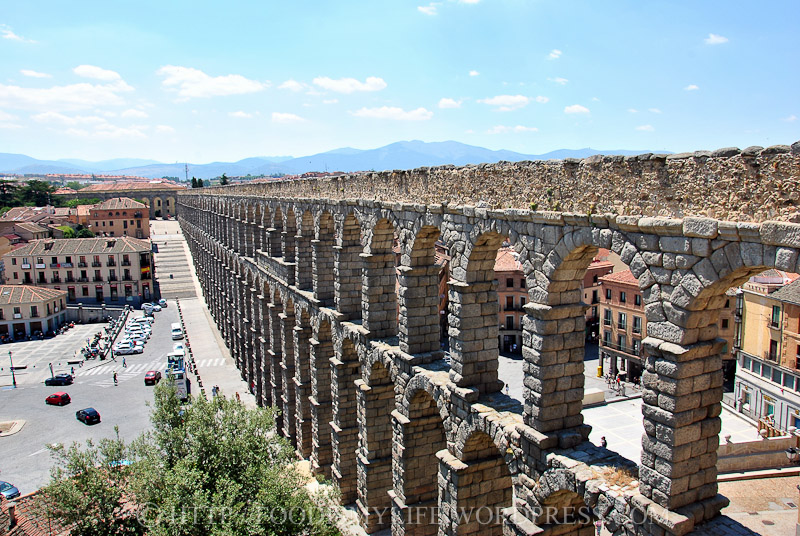
Aqueduct in Segoiva, Spain
We left Valencia for Madrid, but before I blog about Madrid, I’m going to blog about our day trip to Segovia! One popular activity that tourists will do when in Madrid is to take day trips out to visit some nearby towns. We only had enough time to visit one town, and we narrowed our choice down to 2 – Toledo and Segovia. In the end, we decided to visit Segovia mainly because it’s a less touristy destination as compared to Toledo. Fodors and Lonely Planet have interesting debatee on where’s better, so if you’re heading down to Madrid, do research where you’d like and reserve some days for the day trips!
And boy, Segovia is an extremely amazing and charming place! (Do click “more” to see more photos!)
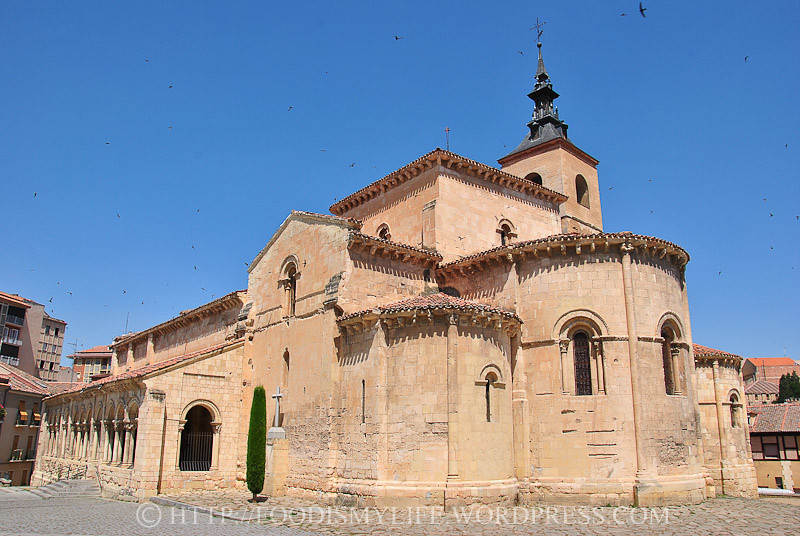
Iglesia San Millán (San Millán Church)
As we walked towards Segovia’s city centre from our drop-off point, we chanced upon a pretty church just outside the old walls of Segovia. This church was built between 1111 and 1124 and is one of the oldest churches in the city.
Did you see lots of black spots in the skies? They were all swallows! (Not the camera lens were dirty…)
Iglesia San Millán (San Millán Church)
Address: Between the bus station and aqueduct outside the old city, just off Avenida de Fernandez Ladreda
Opening hours: Daily 10am – 2pm & 4:30pm – 7:30pm
Cost: Free
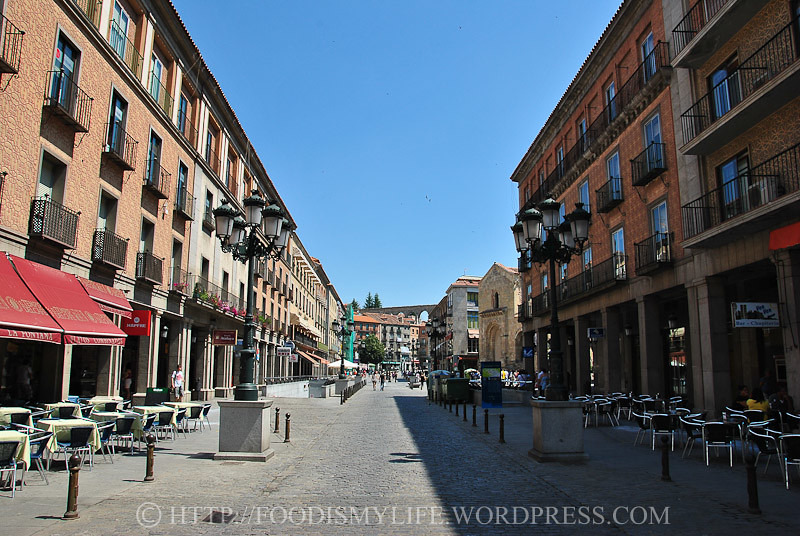
Streets of Segovia – you can see a little bit of the Aqueduct in the background!

Segovia Aqueduct
Segovia Aqueduct is definitely one piece of art that will leave you jaw-dropped and eyes wide open. The magnificent structure really humbled me as I climbed up the steps to have a better look of the aqueduct.
In 1985, the old city of Segovia and its Aqueduct were declared World Heritage by UNESCO. Known as the Aqueduct of Segovia, this Roman bridge is one of the most significant and best-preserved ancient monuments. The aqueduct bridge is even on Segovia’s coat of arms!
It was known that the aqueduct was built as early as 1st century AD and completed in the early 2nd century. It supplied water to Segoiva by transporting water from the Frío River – which was 16 kilometres (10 miles) away!
The construction of the aqueduct follows the principles laid out by Vitruvius as he described in his De Architectura published in the mid-first century. At its highest point, the water channel is actually 30.5 metres (100 feet) above the ground! And the most amazing and stunning fact is that the visible part of the structure are not held together using mortar or cement at all. The stones were precisely cut and stacked on top one another to transmit and bear the load in an unbelievable perfect equilibrium.
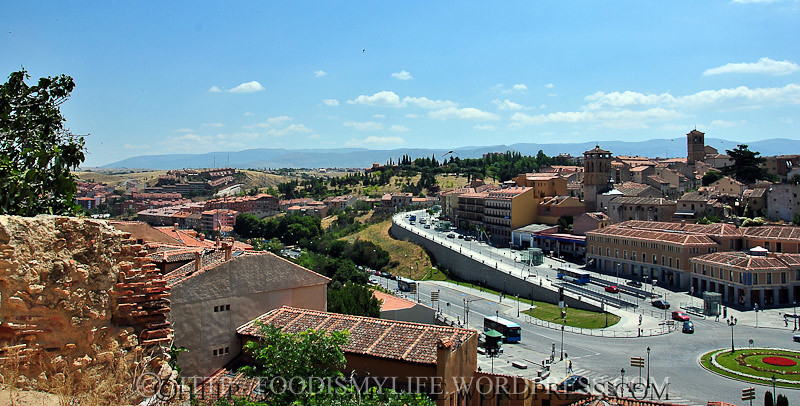
View of the beautiful town of Segovia from the Aqueduct
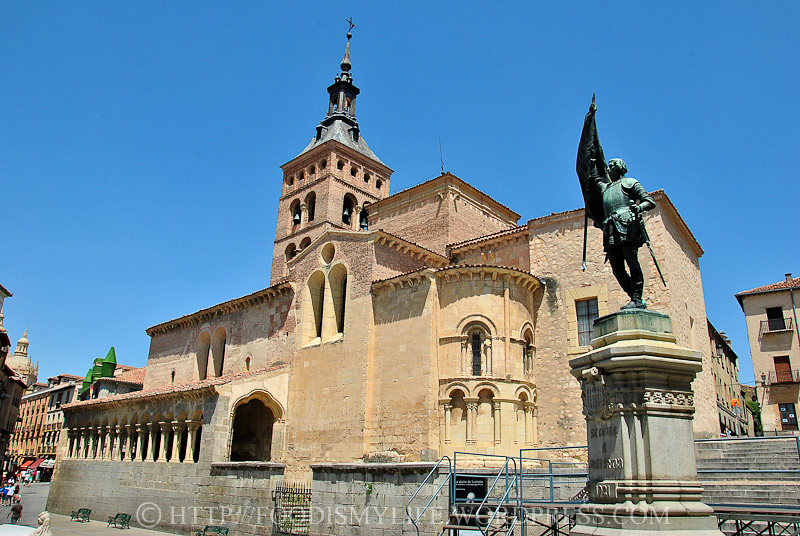
San Martín Church
Dating back to the 12th century, this beautiful church is decorated in Romanesque style. It looks very similar to the San Millán Church we saw earlier.
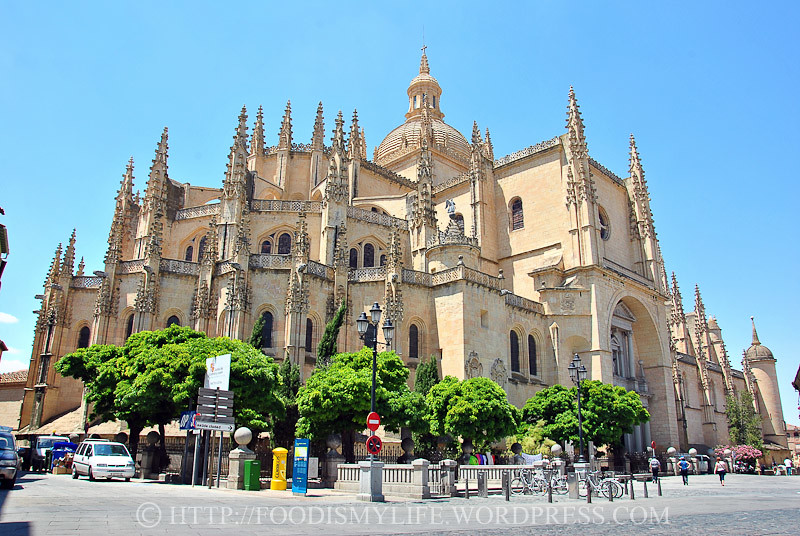
Segovia Cathedral
As we continue walking, we saw a beautiful and stunning cathedral built in Gothic style. Construction for the cathedral started in 1525 and was completed only in 1768. No photos of the interior are taken as photography wasn’t allowed.
Segovia Cathedral
Address: Marqués del Arco 1, Segovia, Spain
Opening hours:
Apr-Sept: Mon-Sat 9am-6:30pm; Sun 9am-2:30pm
Oct-Mar: Mon-Sat 9am-5:30pm; Sun 9am-2:30pm
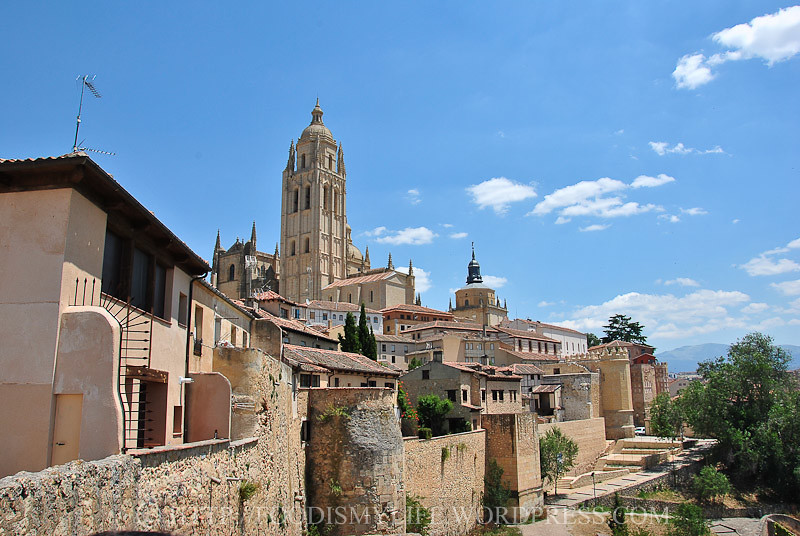
Along the city walls
Leaving the Segovia Cathedral behind, we made our way to the Alcázar of Segovia. We stopped by along the city walls to take some photos.
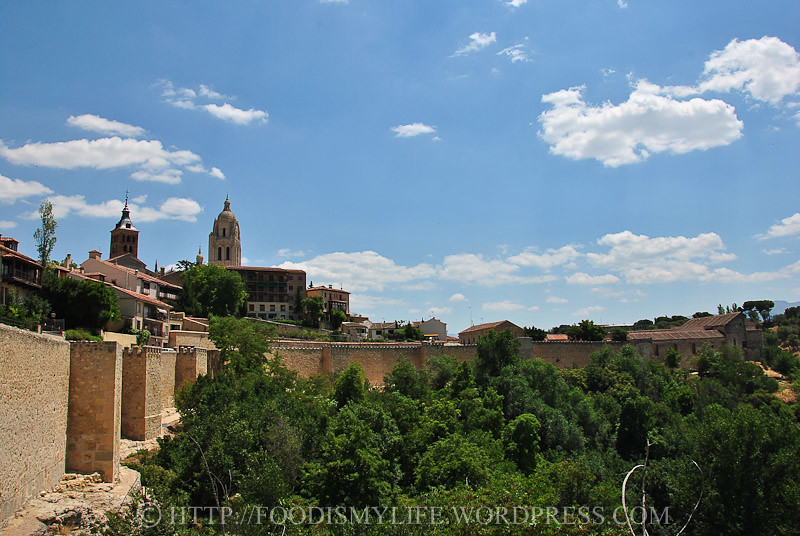
City Walls of Segovia
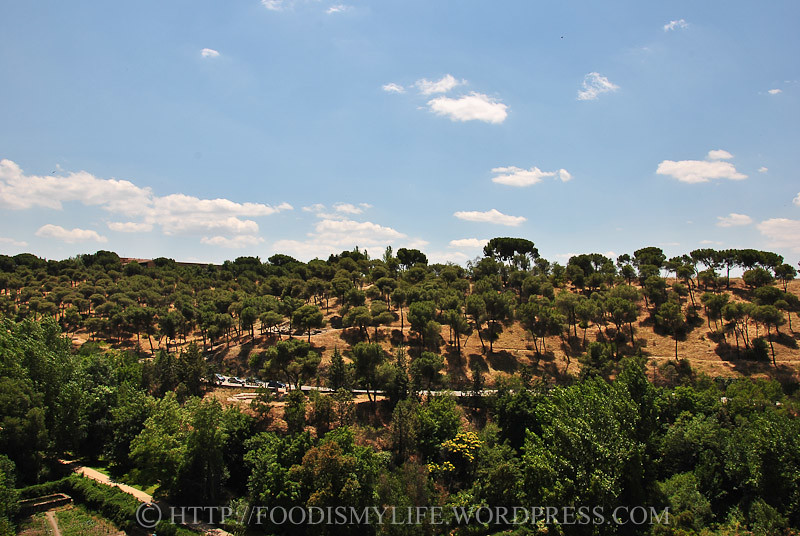
View outside the city walls
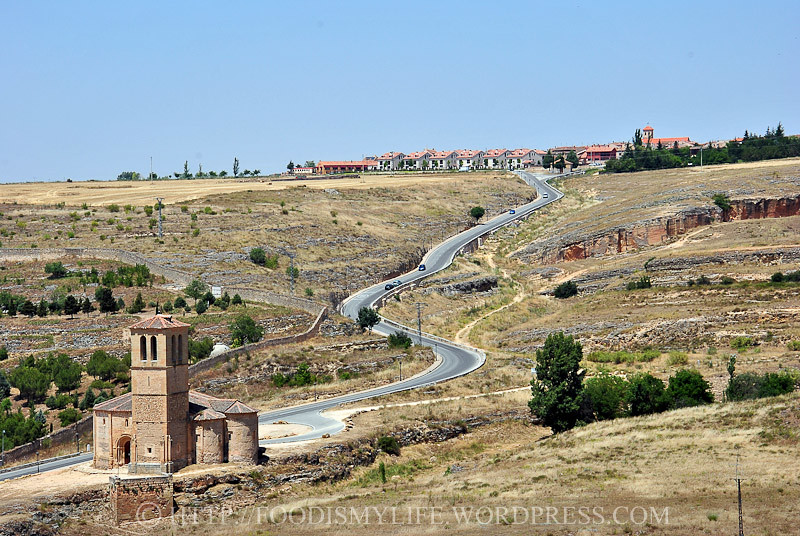
Vera Cruz shrine in the foreground
Really love the meandering long road!
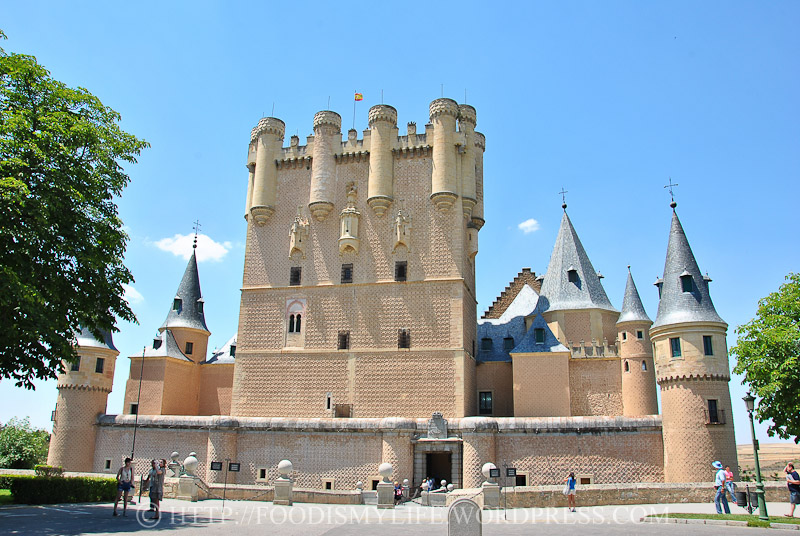
Alcázar of Segovia (Segovia Castle)
The Alcázar is beautiful a stone fortification shaped like the bow of a ship, and it is also known as the Sleeping Beauty’s castle (read that the inspiration of the the fairy tale castle is from this castle!) The castle does not have any Sleeping Beauty for one to kiss, but it had served as a royal palace, a state prison, a Royal Artillery College and a military academy. The interior of the Alcázar is as beautiful as its exterior – there are many apartments and most are decorated with delicate traceries and pendant ornaments, though what we see now are those that are restored as a fire in 1862 destroyed a significant portion of the castle.

Armours…
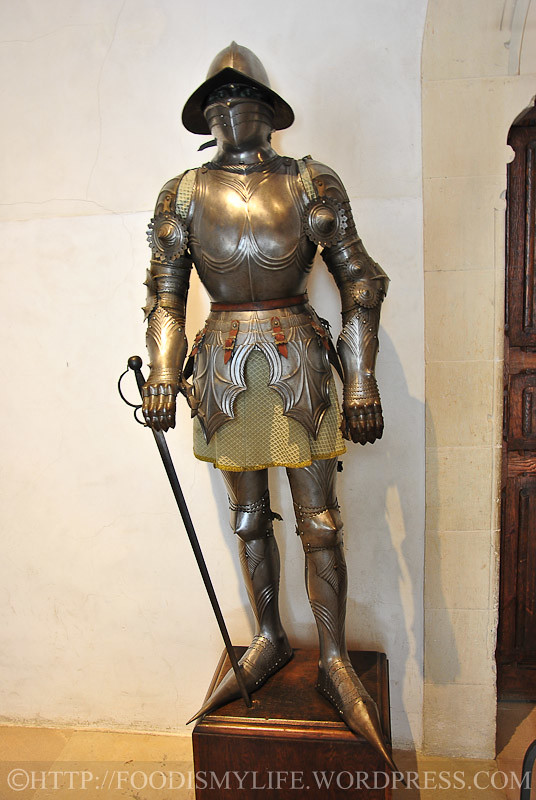
… And armours!

Throne Room

Cord Room
Our eyes are just glued to the ceiling – stunning!
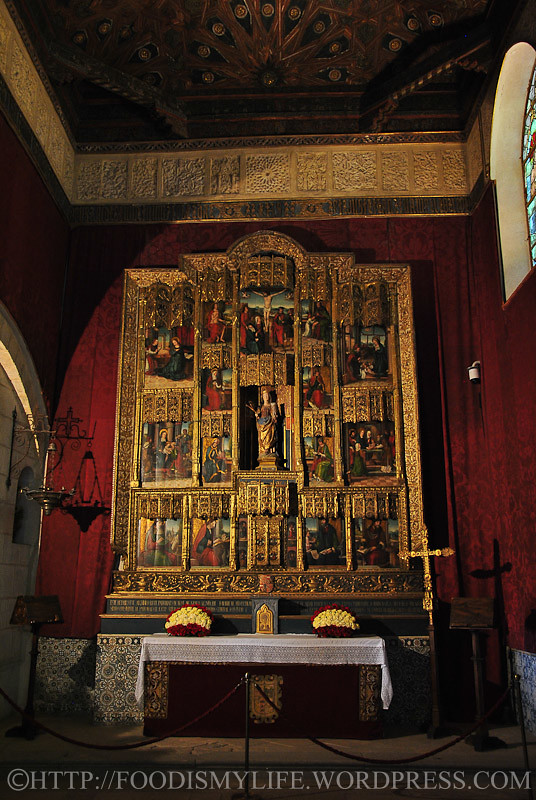
Chapel
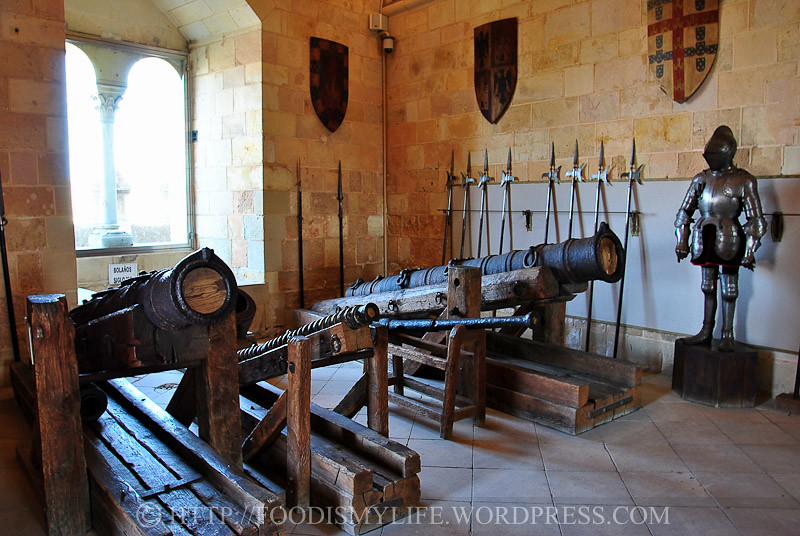
Armoury
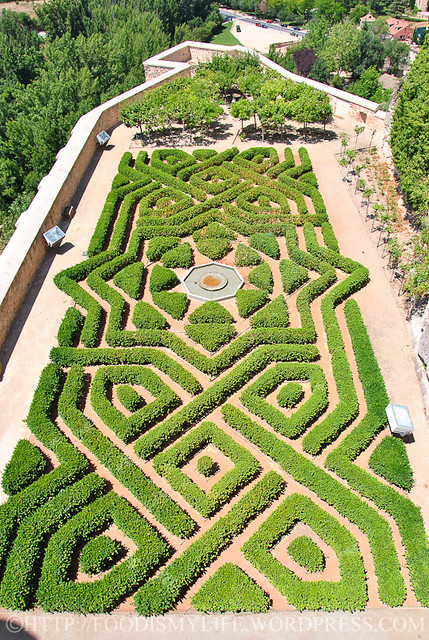
Alcázar Gardens (which we can’t go down to)
I would really love to play a game of hide and seek down there if the shrubs are taller!

View from top of Alcázar
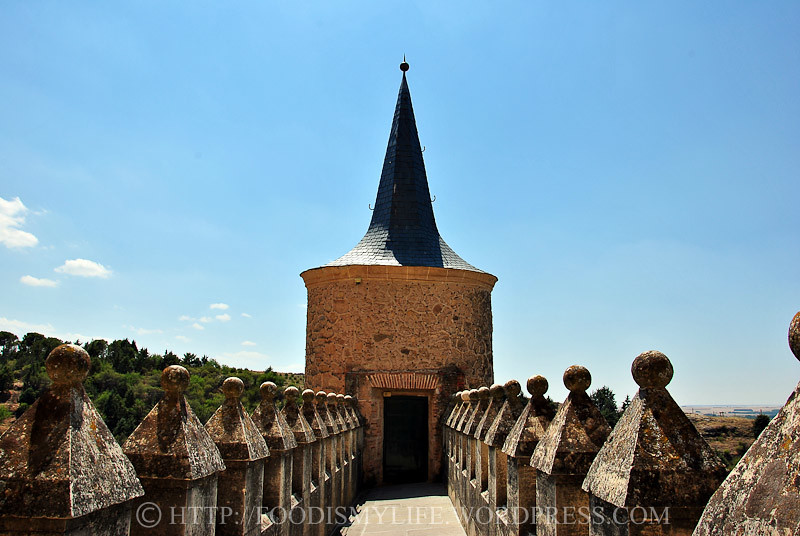

Still a view from top of Alcázar
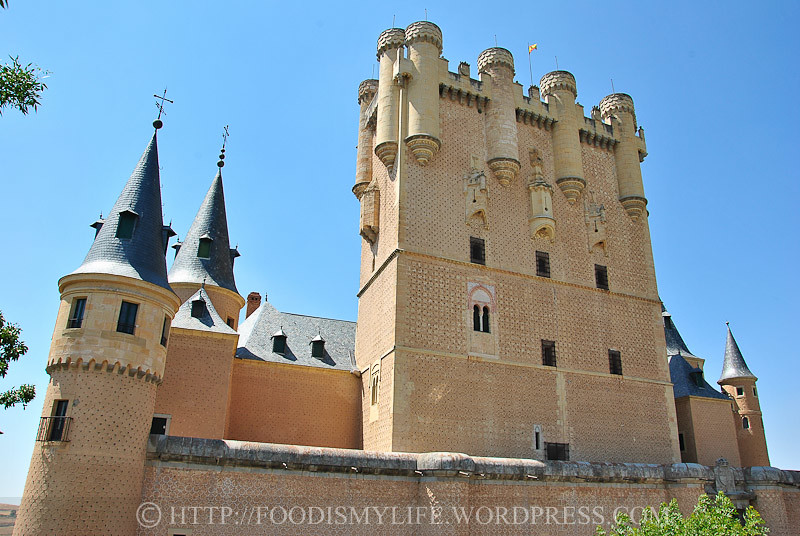
Alcázar
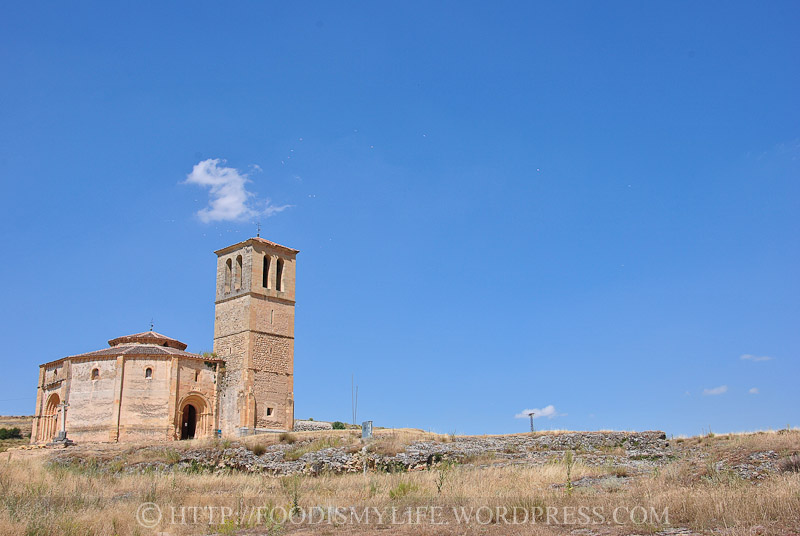
Iglesia Vera Cruz (Church of the True Cross)
After a long walk in the Alcázar, we made our way to down a hill to Vera Cruz (the church we saw earlier over at the city walls).
Consecrated in 1208, Vera Cruz was built by the Knights Templar to house a fragment of the True Cross (which has been shifted) – thus it is primarily a shrine. To me, Vera Cruz is the most beautiful sight in Segovia – standing all alone in the large and beautiful field, there is no construction, no buildings and minimum human presence to disturb the beautiful shrine. The contrast between the skies and the shrine evoked a feeling of beautiful and sacred loneliness in me.

Iglesia Vera Cruz
(Church of the True Cross)
Address:
Valley below the Alcazar, Segovia, Spain
On foot, take the path down to Paseo San Juan de La Cruz.
Opening hours:
Tue-Sun: 10:30-1:30 & 3:30-7pm
Closes 6pm in winter
Closed on Mondays and in November
Price: €1.75
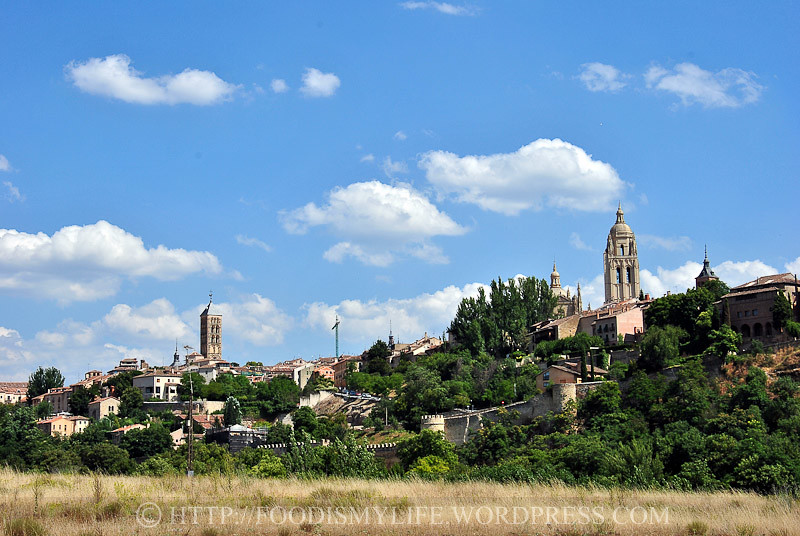
Segovia city

As we were waking back to the city square, X led us through a detour to a very beautiful and luscious green field to see the Alcázar “floating” in mid-air. There are some kids playing soccer and some families having picnics there. We sat down at the field and too plenty of photos of us with the Alcázar in the background. It was indeed a postcard-worthy view!
We didn’t manage to stay in Segovia long enough to have dinner there. It was a really pleasant trip and I couldn’t bear to leave the beautiful place. But all travels have to come to an end, right? So that a new one can start! 😉
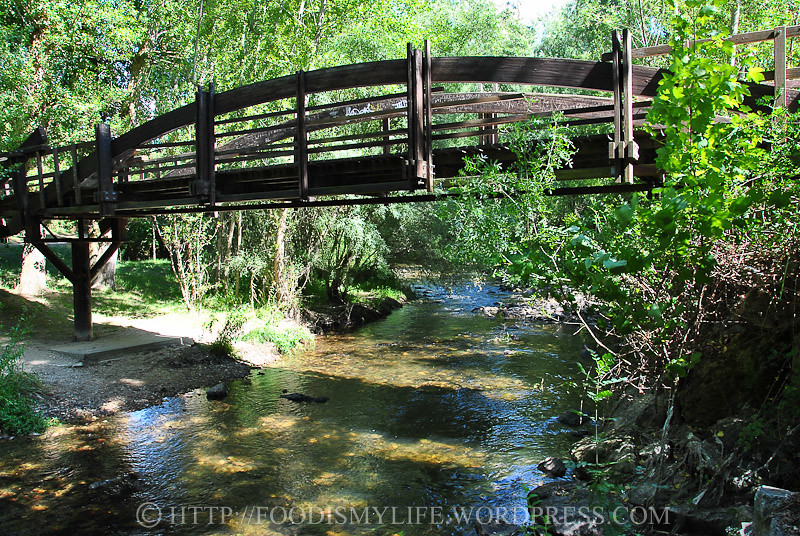
Bridge behind the fields
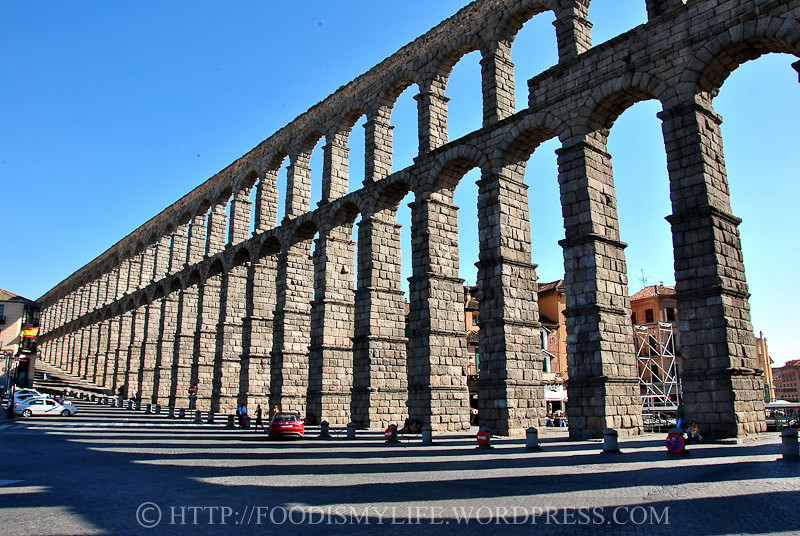
One last pretty view of the aqueduct
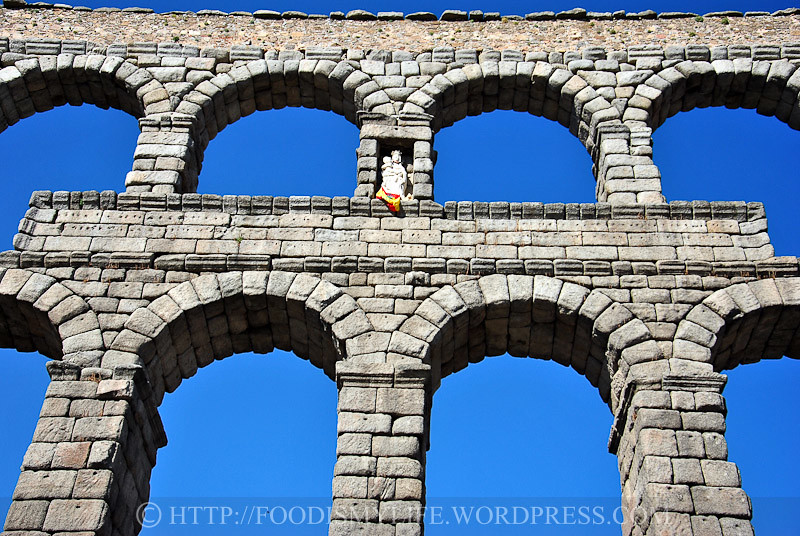
How they manage to get the flag on top the aqueduct baffles me!
Lastly, I think it would be useful to post useful information on how to get to Segovia – there are generally two ways to get there:
By Bus
How: Take a metro to Principe Pio and look for directions to go down to the bus terminal (definitely not difficult to find). Look for La Sepulvedana ticket office and purchase a round-trip ticket for Segovia.
Seats: Seats are pre-assigned, when departing from Segovia, do head to the bus terminal and get your ticket validated as they will assign you a seat then. If you don’t get it validated, you’ll not be allowed to board the bus!
Price: About 15 euros for a round trip
Duration: About 1h 15 minutes, alighting very near the Aqueduct – about 300 metres away from the city centre.
Timing: The bus service runs from 8am to 11pm for Madrid to Segovia and 6.45am to 9.30pm for Segovia to Madrid at every 30 minutes interval.
Others: There’s free WI-FI on the bus! (not always working, but an added bonus if it is!)
By Train
How: Head to Chamartin train station and take a high-speed train from Madrid to Segovia. Upon reaching Segovia train station, take a bus ride from the station to the aqueduct or take a taxi there.
Price: About 15 euros for a round trip – would cost more if you take a cab from Segovia train station (according to research, not confirmed)
Duration: Total 50 minutes – about 30 minutes for the train ride and 20 minutes for the bus ride (according to research, not confirmed)
Timing: Depending on train schedule (not confirmed)
In conclusion, taking a bus is definitely better (which was what we did) as you get to alight nearer to Segovia city centre, and the duration and pricing are not very far off by choosing to go there by train. In addition, you get to see more scenery when you take a bus there!
Quiet and Serene Madrid, Spain (Part 2) « Food Is My Life says
[…] Segoiva, Spain Share if you like it!FacebookTwitterPinterestTumblrLinkedInStumbleUponDiggRedditMorePrintEmailLike this:LikeBe the first to like this. Tags: europe, holiday, madrid, park, photography, photos, retiro park, spain, spanish, tour, Travel, trip, vacation […]
Jasline says
Thank you Bobbi 🙂 I do hope you get to cross it out of your bucket list soon!
Jasline says
Yes you should Villy 😉
Jasline says
Thank you Michelle! I hope you go to Segovia soon, it’s a really beautiful town!
Jasline says
Thank you! Glad you like the post 🙂
Jasline says
Thank you! I really can’t imagine how they built the castle without modern technology! It’s simply amazing!
Jasline says
Thank you! Segovia is a very beautiful town 🙂
Jasline says
Thank you Uru! I’m glad you like them 🙂
Jasline says
Thank you for the compliments John! Yes I’m really amazed throughout my whole trip in Europe, it’s truly an eye-opener and all their architecture are unique and so beautiful!
Jasline says
Thank you for the compliments! Spain is definitely a very interesting place to visit, I hope you get to go there one day 🙂 I can’t wait to see your churros with chocolate, sounds extremely delicious! And why not let’s go for a coffee together to escape from the heat? 😉
Jasline says
Thank you! 🙂
Bam's Kitchen says
Spain is on my bucket list but until then it is fun to see the world through your camera lens.
Villy says
Ok. Now I have to go there! Beautiful photos!
Michelle says
Such lovely photos! I love Spain, though I haven’t made it to Segovia yet. Thanks for taking me there.
girlinafoodfrenzy says
Congrats on post 199 Snd more! Lovely to see the itinerary of your trip & adventure there. I loved the look of the Alcazar gardens, mazes are definitely my thing too!
yummychunklet says
Gorgeous images. I just love those old world castles.
gemmafottles says
Wow, these are awesome pictures. Looks beautiful.
Choc Chip Uru says
Happy 199th post my friend 😉
Thank you for sharing such incredible photos my friend, absolutely stunning!
Cheers
Choc Chip Uru
ChgoJohn says
Really stunning pictures of a beautiful place and you are so right about the architecture. It really does reflect the various peoples that once lived there. Fascinating, isn’t it?
A_Boleyn says
Amazing pictures. Shades of “El Cid”. 🙂
One of the many reasons I would love to visit Spain is to see the different kinds of architecture from the various groups that have occupied/lived there. My nephew was heavily into archaeology as a graduate student and is still interested so I’m sure he’d love to look at these pictures. I’ll have to give him a heads up.
I’m looking forward to your 200th post. I’ve been wanting to make churros with chocolate for some time but the hot weather is preventing me from being too energetic. I’ll think of you visiting a coffee shop and having some after taking all these gorgeous shots.
Quay Po Cooks says
Spectacular sights through your eyes. Thanks.